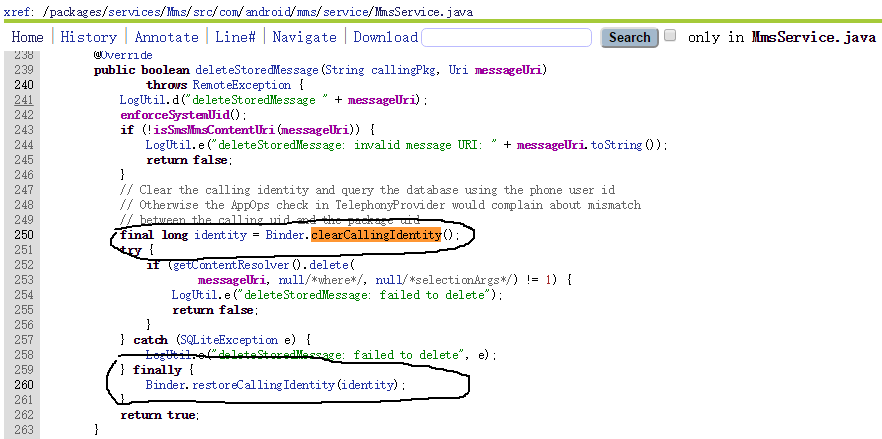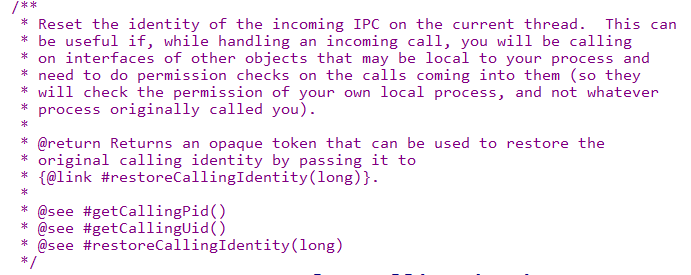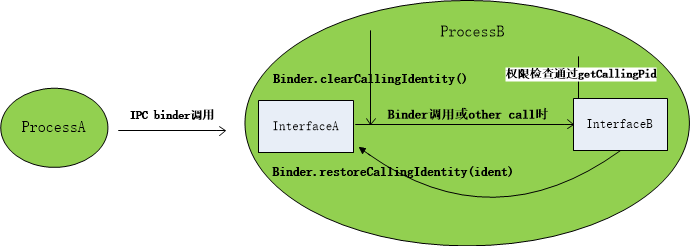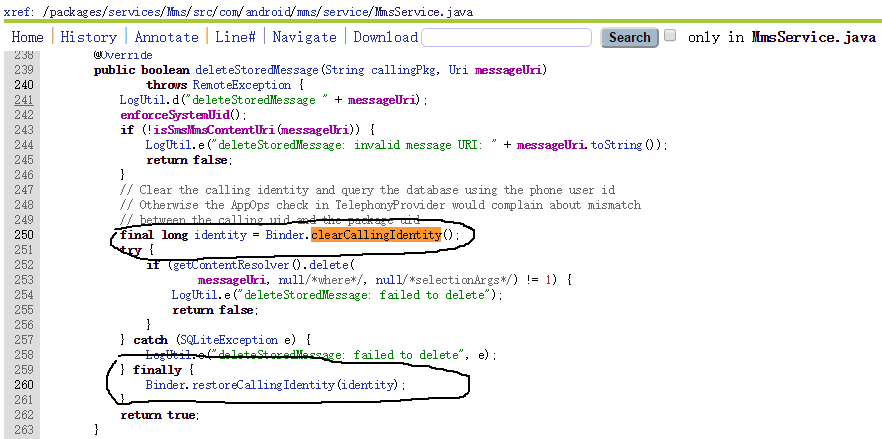
2016-08-14 23:05:00 Author: www.cnblogs.com(查看原文) 阅读量:71 收藏
开机SystemServer到ActivityManagerService启动过程
一 从Systemserver到AMS
zygote-> systemserver:java入层口:
/** * The main entry point from zygote. */ public static void main(String[] args) { new SystemServer().run(); }
接下来继续看SystemServer run函数执行过程:
private void run() {
// 准备SystemServer运行环境:设置线程优先级,创建主线层Looper,ActivityThread和SystemContext
android.os.Process.setThreadPriority();
Looper.prepareMainLooper();
// 创建systemserver上进程的ActivityThread和SystemContext
createSystemContext();
// 增加SystemServiceManager:统一管理system services的创建,启动和生命周期,多用户切换
mSystemServiceManager = new SystemServiceManager(mSystemContext);
// Start services.
// 1.创建AMS
mActivityManagerService = mSystemServiceManager.startService(
ActivityManagerService.Lifecycle.class).getService();
// Start the Power Manager service
mPowerManagerService = mSystemServiceManager.startService(PowerManagerService.class);
// Start the package manager service
mPackageManagerService = PackageManagerService.main();
// 2.将SystemServer进程可加到AMS中调度管理
mActivityManagerService.setSystemProcess();
// 3.将相关provider运行在systemserver进程中:SettingsProvider
mActivityManagerService.installSystemProviders();
//
final Watchdog watchdog = Watchdog.getInstance();
watchdog.init(context, mActivityManagerService);
// Start Window Manager
wm = WindowManagerService.main();
// 4.直接保存wms对象,与WMS交互
mActivityManagerService.setWindowManager(wm);
// 5.通过WMS 弹出“正在启动应用”框
// R.string.android_upgrading_starting_apps
ActivityManagerNative.getDefault().showBootMessage();
// 6. AMS作为Framework核心,做好准备就绪后就开始启动应用层,和对AMS有依赖的服务
mActivityManagerService.systemReady(new Runnable(){
//启动SystemUI
startSystemUi(context);
//启动WatchDog监控核心服务状态
Watchdog.getInstance().start();
//
mmsServiceF.systemRunning();
});
// Loop forever.
Looper.loop();
}
以上6个步骤是SystemServer中关于AMS的调用,完成AMS的创建和系统的初始化,下面按照这步骤继续升入分析。
- 这里有个疑问:
AMS保存对象,本身就在同一个进程,WMS与WMS之间的交互式直接调用速度会更快,其他服务为何不这样,是因为耦合太强,还是实时性要求更高?
弹出“正在启动应用”框,这里为何不直接调用AMS的showBootMessage而是通过binder方式调用,其他接口都是直接调用,为何?直接调用有何不可吗?
二 ActivityManagerService 创建过程
接上面SystemServer.run中:
mActivityManagerService = mSystemServiceManager.startService(
ActivityManagerService.Lifecycle.class).getService();
这是通过SystemServiceManager这样一个模板类来创建运行在SystemServer中的Framework服务;
并将创建的服务统一保存在队列管理,会涉及到多用户切换。
// Note: This method is invoked on the main thread but may need to attach various // handlers to other threads. So take care to be explicit about the looper. public ActivityManagerService(Context systemContext) {
// 1.系统Context 和 ActivityThread (将systemserver进程作为应用进程管理) mContext = systemContext; mFactoryTest = FactoryTest.getMode(); mSystemThread = ActivityThread.currentActivityThread(); // 2.AMS工作的线程和Handler,处理显示相关的UiHandler ---》知识点HandlerThread和Handler mHandlerThread = new ServiceThread(TAG, android.os.Process.THREAD_PRIORITY_FOREGROUND, false /*allowIo*/); mHandlerThread.start(); mHandler = new MainHandler(mHandlerThread.getLooper()); mUiHandler = new UiHandler(); // 3. 广播队列BroadcastQueue初始化:前台广播队列和后台广播队列 mFgBroadcastQueue = new BroadcastQueue(this, mHandler,"foreground", BROADCAST_FG_TIMEOUT, false); mBgBroadcastQueue = new BroadcastQueue(this, mHandler,"background", BROADCAST_BG_TIMEOUT, true); mBroadcastQueues[0] = mFgBroadcastQueue; mBroadcastQueues[1] = mBgBroadcastQueue; // 4. Service 和 Provider 管理 mServices = new ActiveServices(this); mProviderMap = new ProviderMap(this); // 5.系统数据存放目录:/data/system/ File dataDir = Environment.getDataDirectory(); File systemDir = new File(dataDir, "system"); systemDir.mkdirs(); // 电池状态信息,进程状态 和 应用权限管理 mBatteryStatsService = new BatteryStatsService(systemDir, mHandler); mProcessStats = new ProcessStatsService(this, new File(systemDir, "procstats")); mAppOpsService = new AppOpsService(new File(systemDir, "appops.xml"), mHandler); // 6.多用户管理 mStartedUsers.put(UserHandle.USER_OWNER, new UserState(UserHandle.OWNER, true)); mUserLru.add(UserHandle.USER_OWNER); updateStartedUserArrayLocked(); // 7.最近任务,Activity,Task管理 mRecentTasks = new RecentTasks(this); mStackSupervisor = new ActivityStackSupervisor(this, mRecentTasks); mTaskPersister = new TaskPersister(systemDir, mStackSupervisor, mRecentTasks); // 创建一个新线程,用于监控和定时更新系统CPU信息,30分钟更新一次CPU和电池信息 mProcessCpuTracker.init(); mProcessCpuThread = new Thread("CpuTracker") {} // 加入Watchdog监控起来 Watchdog.getInstance().addMonitor(this); Watchdog.getInstance().addThread(mHandler); }
- 以上 AMS创建过程 涉及到Android 四大组件管理的初始化:
Broadcast --》BroadcastQueue
Provider --》ProviderMap
Service --》ActiveServices
Activity --》ActivityStackSupervisor
备注1:Android6.0上加入多用户功能,增加了一些涉及多用户的管理。
拓展知识点:HandlerThread,Handle,Looper
二 将SystemServer进程可加到AMS中调度管理
接上面systemserver.run中:
mActivityManagerService.setSystemProcess();
public void setSystemProcess() {
// 将服务加入到ServiceManager中
ServiceManager.addService(Context.ACTIVITY_SERVICE, this, true);
ServiceManager.addService(ProcessStats.SERVICE_NAME, mProcessStats);
ServiceManager.addService("meminfo", new MemBinder(this));
ServiceManager.addService("gfxinfo", new GraphicsBinder(this));
ServiceManager.addService("dbinfo", new DbBinder(this));
// 设置application info LoadedApkinfo 有关 framework-res.apk
ApplicationInfo info = mContext.getPackageManager().getApplicationInfo(
"android", STOCK_PM_FLAGS);
mSystemThread.installSystemApplicationInfo(info, getClass().getClassLoader());
//给SystemServer进程创建ProcessRecord,adj值,就是将SystemServer进程加入到AMS进程管理机制中,跟应用进程一致
synchronized (this) {
ProcessRecord app = newProcessRecordLocked(info, info.processName, false, 0);
app.persistent = true;
app.pid = MY_PID;
app.maxAdj = ProcessList.SYSTEM_ADJ;
app.makeActive(mSystemThread.getApplicationThread(), mProcessStats);
synchronized (mPidsSelfLocked) {
mPidsSelfLocked.put(app.pid, app);
}
updateLruProcessLocked(app, false, null);
updateOomAdjLocked();
}
}
- setSystemProcess意义:
这一步就是给SystemServer进程创建ProcessRecord,adj值,就是将SystemServer进程加入到AMS进程管理机制中,跟应用进程一致;
进程调度更新优先级oomadj值,个人感觉SystemServer进程跟应用进程就不一样,却加入AMS来调度管理,这样做的意义何在?
四 创建运行在SystemServer进程中Provider
接上面SystemServer.run中:
mActivityManagerService.installSystemProviders();
备注2: 将相关provider运行在systemserver进程中:SettingsProvider
具体安装过程这里暂不详述,在应用启动过程中具体分析。
五 AMS systemReady过程
接上面SystemServer.run中:
mActivityManagerService.systemReady();
public void systemReady(final Runnable goingCallback) {
synchronized(this) {
if (mSystemReady) {
goingCallback.run();
}
……
// 1.升级相关处理:发送PRE_BOOT_COMPLETED广播 等待升级处理完成才能继续
// Check to see if there are any update receivers to run.
if (!mDidUpdate) {
// 等待升级完成,否则直接返回
if (mWaitingUpdate) {
return;
}
// 发送PRE_BOOT_COMPLETED广播
final ArrayList<ComponentName> doneReceivers = new ArrayList<ComponentName>();
mWaitingUpdate = deliverPreBootCompleted(new Runnable() {
// 等待所有接收PRE_BOOT_COMPLETED广播者处理完毕
public void run() {
synchronized (ActivityManagerService.this) {
mDidUpdate = true;
}
showBootMessage(mContext.getText(
R.string.android_upgrading_complete),
false);
// 将系统版本号和处理过的广播写入文件:/data/system/called_pre_boots.dat文件
writeLastDonePreBootReceivers(doneReceivers);
// 继续systemReady流程
systemReady(goingCallback);
}
}, doneReceivers, UserHandle.USER_OWNER);
if (mWaitingUpdate) {
return;
}
mDidUpdate = true;
}
mSystemReady = true;
}
// 2. 收集已经启动的进程并杀死,除过persistent常驻进程
ArrayList<ProcessRecord> procsToKill = null;
synchronized(mPidsSelfLocked) {
for (int i=mPidsSelfLocked.size()-1; i>=0; i--) {
ProcessRecord proc = mPidsSelfLocked.valueAt(i);
if (!isAllowedWhileBooting(proc.info)){
if (procsToKill == null) {
procsToKill = new ArrayList<ProcessRecord>();
}
procsToKill.add(proc);
}
}
}
synchronized(this) {
if (procsToKill != null) {
for (int i=procsToKill.size()-1; i>=0; i--) {
ProcessRecord proc = procsToKill.get(i);
Slog.i(TAG, "Removing system update proc: " + proc);
removeProcessLocked(proc, true, false, "system update done");
}
}
// Now that we have cleaned up any update processes, we
// are ready to start launching real processes and know that
// we won't trample on them any more.
mProcessesReady = true;
}
// 3.系统准备好后回调传入的Runnable:
if (goingCallback != null) goingCallback.run();
// 4. 发送账户启动的广播,涉及多用户
long ident = Binder.clearCallingIdentity();
Intent intent = new Intent(Intent.ACTION_USER_STARTED);
broadcastIntentLocked(intent);
intent = new Intent(Intent.ACTION_USER_STARTING);
broadcastIntentLocked(intent);
Binder.restoreCallingIdentity(ident);
// 5. 启动桌面Home Activity
mBooting = true;
startHomeActivityLocked(mCurrentUserId, "systemReady");
mStackSupervisor.resumeTopActivitiesLocked();
}
- 下面看下AMS systemReady的过程:
1. 升级相关处理:发送PRE_BOOT_COMPLETED广播
顾名思义:只有系统做OTA升级 和 手机初次开机的时候,应当才会走此广播,下面看看这个函数具体的处理。
接上面:
deliverPreBootCompleted(new Runnable() {
// 向PMS查询,所有接收ACTION_PRE_BOOT_COMPLETED广播的Receiver
Intent intent = new Intent(Intent.ACTION_PRE_BOOT_COMPLETED);
List<ResolveInfo> ris = null;
ris = AppGlobals.getPackageManager().queryIntentReceivers(
intent, null, 0, userId);
// 只有系统广播才能接收该广播,去掉非系统应用
for (int i=ris.size()-1; i>=0; i--) {
if ((ris.get(i).activityInfo.applicationInfo.flags
&ApplicationInfo.FLAG_SYSTEM) == 0) {
ris.remove(i);
}
}
// 给Intent设置flag:FLAG_RECEIVER_BOOT_UPGRADE,很关键这个看看flag的作用:
// 只有设置这个标志,才能让应用在系统没有ready的情况下启动,见下文原始注释
intent.addFlags(Intent.FLAG_RECEIVER_BOOT_UPGRADE);
// 将已经处理过ACTION_PRE_BOOT_COMPLETED广播的Receiver去掉
// 已经处理该广播的Receiver记录 和 对应的系统版本号 都记录在:/data/system/called_pre_boots.dat文件中,
// 通过与系统当前版本号比对,确认是否已处理过。考虑处理过程异常中断的情况:比如断电
ArrayList<ComponentName> lastDoneReceivers = readLastDonePreBootReceivers();
// 将已经处理过的广播去除,同时记录已处理过保存在 doneReceivers数组中
for (int i=0; i<ris.size(); i++) {
ActivityInfo ai = ris.get(i).activityInfo;
ComponentName comp = new ComponentName(ai.packageName, ai.name);
if (lastDoneReceivers.contains(comp)) {
// We already did the pre boot receiver for this app with the current
// platform version, so don't do it again...
ris.remove(i);
i--;
// ...however, do keep it as one that has been done, so we don't
// forget about it when rewriting the file of last done receivers.
doneReceivers.add(comp);
}
}
// 内部类专门用来ACTION_PRE_BOOT_COMPLETED广播的发送,要看看这个PreBootContinuation类
// 这块逻辑一直在变,Android5.0, 6.0 , 以及看到在7.0上又变了,基本思路不变,本文代码基于Android6.0
PreBootContinuation cont = new PreBootContinuation(intent, onFinishCallback, doneReceivers,
ris, users);
cont.go();
return true;
}
给intent设置的广播意义:
/**
* Set when this broadcast is for a boot upgrade, a special mode that
* allows the broadcast to be sent before the system is ready and launches
* the app process with no providers running in it.
* @hide
*/
public static final int FLAG_RECEIVER_BOOT_UPGRADE = 0x02000000;
- 继续接着上面PreBootContinuation类:从继承关系看到可以跨进程的
final class PreBootContinuation extends IIntentReceiver.Stub {
void go() {
//判断是不是最后一个接收者
if (lastRi != curRi) {
// 疑问:如果不是最后一个接收者,则发给一个指定接收者ComponentName
// 为什么要在这里指定接收者,一个个发送,而不是交给广播自己去处理?
ActivityInfo ai = ris.get(curRi).activityInfo;
ComponentName comp = new ComponentName(ai.packageName, ai.name);
intent.setComponent(comp);
doneReceivers.add(comp);
lastRi = curRi;
// 界面显示正在处理的广播,上面的指定接收者,就是为了这里能显示正在处理的广播名称?
CharSequence label = ai.loadLabel(mContext.getPackageManager());
showBootMessage(mContext.getString(R.string.android_preparing_apk, label), false);
}
// 发送广播,指定接收者处理完毕,会resultTo回来--》this
Slog.i(TAG, "Pre-boot of " + intent.getComponent().toShortString()
+ " for user " + users[curUser]);
broadcastIntentLocked(null, null, intent, null, this,
0, null, null, null, AppOpsManager.OP_NONE,
null, true, false, MY_PID, Process.SYSTEM_UID, users[curUser]);
}
public void performReceive(Intent intent, int resultCode,
String data, Bundle extras, boolean ordered,
boolean sticky, int sendingUser) {
// 指定接收者广播处理完毕回调resultTo回来,继续处理下一个,如果所有处理完,则post消息执行onFinishCallback
curUser++;
if (curUser >= users.length) {
curUser = 0;
curRi++;
if (curRi >= ris.size()) {
// All done sending broadcasts!
if (onFinishCallback != null) {
// The raw IIntentReceiver interface is called
// with the AM lock held, so redispatch to
// execute our code without the lock.
mHandler.post(onFinishCallback);
}
return;
}
}
go();
}
}
备注1:
在Android L版本上:是直接发送广播,通过action:PRE_BOOT_COMPLETED,AMS会去发给各个接收者。处理完毕回调resultTo回来;
在Android M版本上:这里就直接指定接收者,一个个发送出去,处理完毕回调resultTo回来,继续下一个。界面上可以看到在变化:显示正在处理的广播;
这样做的好处界面体验更好,木有看出有什么其他特别的用意。
备注2:
系统都有哪些地方接收PRE_BOOT_COMPLETED,以及什么情况下应该接收该广播?
从目前看到的主要应用在数据库应用升级方面,数据库升级涉及到数据字段变化,数据的增加等会比较耗时,
为了加快应用启动和提供数据,需要在开机过程中做升级操作,避免使用时耗时。
备注3:
这里其实存在一个隐患:从上面的流程看到,系统发送广播给接收者处理,只有等所有接收者处理完毕,才会继续系统的启动流程。
试想:如果某个接收者的操作处理耗时较长,甚至被阻塞 或其他异常导致广播处理无法完成,不能回调回来怎么办?
结果:开机时间需要的更长了,或无法开机,一直就卡在这里无法开机。
很不幸,这种情况被我遇到过,大概是这样的:
某次Hota升级某应用A注册PRE_BOOT_COMPLETED广播,处理该广播时,由于某种情况需要访问应用B的数据库,等待应用B启动,
由于系统没有ready和应用B非persisit进程,系统不让启动B,结果系统就被阻塞在这里,始终无法开机。
这其实是系统不合理的地方,没有相应的超时控制的安全机制,所幸这里只允许系统应用接收该广播,如果允许第三方接收,后果可想而知。
2. 收集已经启动的进程并杀死除过persistent进程
比如接收PRE_BOOT_COMPLETED启动的应用
到此系统准备完毕,可以开始启动应用进程,并置变量:mProcessesReady = true;
疑问:系统还没准备之前不允许启动非persistent进程,这之前的接收PRE_BOOT_COMPLETED广播的应用是如何启动的?
--》见应用启动部分分析。
3. 系统准备好后回调传入的Runnable
启动应用和服务:{
startSystemUi(context);
connectivityF.systemReady();
……
Watchdog.getInstance().start();
mmsServiceF.systemRunning();
}
4. 发送账户启动的广播,涉及多用户
多用户的问题这里不讨论。
注意发送该广播前有如下操作:成对出现
//操作前 clear
long ident = Binder.clearCallingIdentity();
//do相关操作
……
//操作后restore
Binder.restoreCallingIdentity(ident);
通常这俩都是成对出现,具体的作用简单说下:这涉及到权限管理后面会讨论。
Binder.clearCallingIdentity():
通过IPC binder调用来远端进程,当前进程会记录调用者的PID和UID,即通常使用的getCallingPid和getCallingUid,
而会clearCallingIdentity把调用者PID和UID清除,将其设置为当前进程的PID和UID,并将原来的PID和UID作为返回值;
PID和UID是保存在一个long型数中,通过移位计算。
Binder.restoreCallingIdentity(ident):恢复刚才清除的远端调用者的PID和UID。
这样做有什么作用?
这涉及到权限管理,clearCallingIdentity接口注释,举了incoming call例子,看下原注释:

大概的意思可以理解成这样:

在ProcessB中,InterfaceA调用InterfaceB时,InterfaceB中要做权限检查,通过getCallingPid,
这时拿到的PID是ProcessA的,权限不够肿么办。ProcessB的权限是够可以的:就可以如下面

代码里面很多这样的例子,具体原因请自行体会,贴一段源代码看看

5. 启动桌面Home Activity
接上面systemReady最后部分:
// Start up initial activity.
mBooting = true;
startHomeActivityLocked(mCurrentUserId, "systemReady");
mStackSupervisor.resumeTopActivitiesLocked();
一张图说明AMS启动如上整个过程:

AMS的systemready过程基本如上,整个系统准备OK,下面就将开始启动桌面流程,进入到应用启动过程分析,应用和组件的启动将在下一篇分析。
如有侵权请联系:admin#unsafe.sh